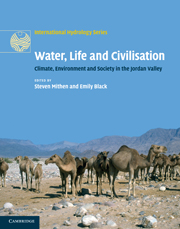Book contents
- Frontmatter
- Contents
- List of figures
- List of tables
- List of contributors
- Acknowledgements
- 1 Introduction: an interdisciplinary approach to Water, Life and Civilisation
- Part I Past, present and future climate
- Part II The palaeoenvironmental record
- Part III Hydrological studies of the Jordan Valley
- Part IV Human settlement, climate change, hydrology and water management
- Part V Palaeoeconomies and developing archaeological methodologies
- 20 The reconstruction of diet and environment in ancient Jordan by carbon and nitrogen stable isotope analysis of human and animal remains
- 21 Irrigation and phytolith formation: an experimental study
- 22 An investigation into the archaeological application of carbon stable isotope analysis used to establish crop water availability: solutions and ways forward
- 23 Past plant use in Jordan as revealed by archaeological and ethnoarchaeological phytolith signatures
- Part VI Society, economy and water today
- Part VII Conclusions
- Index
- Plate section
- References
20 - The reconstruction of diet and environment in ancient Jordan by carbon and nitrogen stable isotope analysis of human and animal remains
from Part V - Palaeoeconomies and developing archaeological methodologies
Published online by Cambridge University Press: 26 April 2011
- Frontmatter
- Contents
- List of figures
- List of tables
- List of contributors
- Acknowledgements
- 1 Introduction: an interdisciplinary approach to Water, Life and Civilisation
- Part I Past, present and future climate
- Part II The palaeoenvironmental record
- Part III Hydrological studies of the Jordan Valley
- Part IV Human settlement, climate change, hydrology and water management
- Part V Palaeoeconomies and developing archaeological methodologies
- 20 The reconstruction of diet and environment in ancient Jordan by carbon and nitrogen stable isotope analysis of human and animal remains
- 21 Irrigation and phytolith formation: an experimental study
- 22 An investigation into the archaeological application of carbon stable isotope analysis used to establish crop water availability: solutions and ways forward
- 23 Past plant use in Jordan as revealed by archaeological and ethnoarchaeological phytolith signatures
- Part VI Society, economy and water today
- Part VII Conclusions
- Index
- Plate section
- References
Summary
ABSTRACT
Diet reconstruction by carbon and nitrogen stable isotope analysis of human and faunal skeletal remains can shed light on exploitation of resources in ancient Jordan and may contribute to the understanding of past environments. This contribution reports on the results of a diachronic investigation of dietary and environmental change in the north of Jordan by stable isotope analysis. Dates of samples range between the Middle Bronze Age and the Early Islamic period, and the archaeological sites included in the discussion are Gerasa, Ya‘amūn, Yajūz and Sa‘ad, in the Western Highlands, and Pella, in the Jordan Valley. Results indicate the predominance of foods derived from C3 plants in the human diet over all periods, as part of a mixed diet of plant and animal protein. Raised carbon stable isotope ratios for some domestic herbivores show that C4 plants were consumed. These were sometimes combined with high δ15N values, which suggest animal husbandry strategies that made use of arid environments.
THE ISOTOPIC APPROACH IN THE STUDY OF DIET AND ECOLOGY OF ANCIENT JORDAN
Stable isotope analysis of bone collagen is an established methodology that allows diet reconstruction at an individual level (Ambrose, 1993; Katzenberg, 2000; Sealy, 2001). It can, therefore, complement information on food resources obtained through the study of faunal and botanical remains, as well as information from textual sources. Moreover, as bone collagen isotopic composition is related to certain habitat characteristics, such as aridity (Heaton, 1987; Ambrose and DeNiro, 1989), this technique may also improve the understanding of past environments.
- Type
- Chapter
- Information
- Water, Life and CivilisationClimate, Environment and Society in the Jordan Valley, pp. 337 - 346Publisher: Cambridge University PressPrint publication year: 2011
References
- 3
- Cited by



